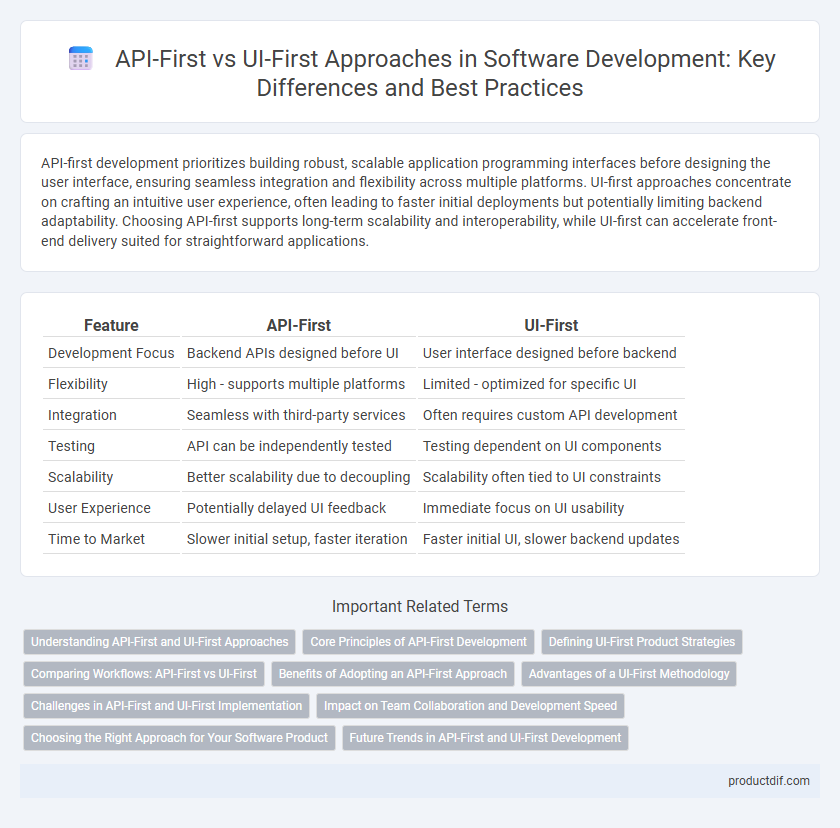API-first development prioritizes building robust, scalable application programming interfaces before designing the user interface, ensuring seamless integration and flexibility across multiple platforms. UI-first approaches concentrate on crafting an intuitive user experience, often leading to faster initial deployments but potentially limiting backend adaptability. Choosing API-first supports long-term scalability and interoperability, while UI-first can accelerate front-end delivery suited for straightforward applications.
Table of Comparison
| Feature | API-First | UI-First |
|---|---|---|
| Development Focus | Backend APIs designed before UI | User interface designed before backend |
| Flexibility | High - supports multiple platforms | Limited - optimized for specific UI |
| Integration | Seamless with third-party services | Often requires custom API development |
| Testing | API can be independently tested | Testing dependent on UI components |
| Scalability | Better scalability due to decoupling | Scalability often tied to UI constraints |
| User Experience | Potentially delayed UI feedback | Immediate focus on UI usability |
| Time to Market | Slower initial setup, faster iteration | Faster initial UI, slower backend updates |
Understanding API-First and UI-First Approaches
API-first development prioritizes designing and building the application programming interface before creating the user interface, ensuring seamless integration and scalability for multiple platforms. UI-first focuses on designing the user interface initially to deliver an optimal user experience but may require additional adjustments to the backend APIs. Choosing between API-first and UI-first approaches depends on project requirements, integration complexity, and the need for consistent data management across devices.
Core Principles of API-First Development
API-first development prioritizes designing and building robust, scalable APIs before creating the user interface, ensuring seamless integration and consistent data management across platforms. Its core principles include defining clear API specifications using standards like OpenAPI, emphasizing reusability and modularity to accelerate development cycles, and adopting strong version control to maintain backward compatibility. This approach enhances collaboration between front-end and back-end teams, promoting faster innovation and improving overall software quality.
Defining UI-First Product Strategies
UI-first product strategies prioritize designing the user interface before developing the backend or APIs, ensuring the product delivers a seamless and intuitive user experience. This approach emphasizes wireframing, prototyping, and user testing early in the development process to align features with customer needs and expectations. UI-first strategies facilitate faster feedback cycles and help teams build visually compelling applications that drive user engagement and satisfaction.
Comparing Workflows: API-First vs UI-First
API-first workflows prioritize designing and documenting backend services through robust, well-defined endpoints, enabling seamless integration and scalable application development. UI-first workflows focus on creating intuitive interfaces and user experiences upfront, often relying on mock data or backend stubs that may lead to iterative backend adjustments. A comparison reveals that API-first promotes parallel development and better cross-team collaboration, while UI-first emphasizes immediate user feedback and rapid prototype validation.
Benefits of Adopting an API-First Approach
API-first development accelerates integration by enabling consistent, reusable interfaces that support multiple platforms and devices, reducing time-to-market. Decoupling backend and frontend workflows enhances collaboration across development teams, improving scalability and maintainability of software systems. Robust API documentation and standardized protocols foster easier onboarding, increase developer productivity, and ensure seamless third-party integrations.
Advantages of a UI-First Methodology
A UI-first methodology accelerates user-centric design by prioritizing intuitive interfaces that enhance user experience and engagement. It enables direct feedback on visual elements early in development, reducing costly revisions and improving overall product usability. This approach aligns development teams around user needs, fostering collaboration and more efficient iteration cycles.
Challenges in API-First and UI-First Implementation
API-first implementation faces challenges in designing comprehensive and consistent endpoints that meet diverse client needs while ensuring backward compatibility during iterative development. UI-first approaches struggle with tight coupling between interface design and backend logic, leading to difficulties in scalability and adaptability when the user experience demands change. Both methodologies require careful coordination between frontend and backend teams to prevent integration issues and maintain seamless functionality throughout the development lifecycle.
Impact on Team Collaboration and Development Speed
API-first development enhances team collaboration by enabling backend and frontend teams to work in parallel with clearly defined contracts, reducing dependencies and accelerating development speed. UI-first approaches can slow down progress as frontend design often relies on backend availability, causing bottlenecks in iteration cycles. Prioritizing API-first methodology streamlines workflows, improves communication, and results in faster product delivery.
Choosing the Right Approach for Your Software Product
Choosing between API-first and UI-first approaches depends on your software product's goals and target users. API-first development ensures robust backend services and seamless integration capabilities, ideal for complex, scalable systems or multi-platform support. UI-first prioritizes user interface design, focusing on user experience and immediate visual feedback, suitable for consumer-facing applications with rich interactivity.
Future Trends in API-First and UI-First Development
API-first development is increasingly prioritized for enabling seamless integration and supporting microservices architectures, driving rapid innovation and scalability in cloud-native applications. UI-first approaches continue evolving with advanced frameworks and AI-driven design tools, emphasizing user experience personalization and accessibility. Future trends indicate a hybrid model leveraging API-first robustness alongside UI-first creativity to deliver flexible, responsive software solutions.
API-first vs UI-first Infographic

 productdif.com
productdif.com